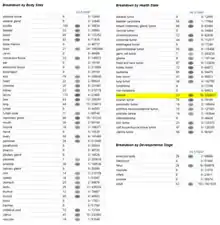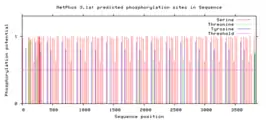NBPF19
Neuroblastoma breakpoint family member 19, or NBPF19, is a protein that in humans is encoded by the NBPF19 gene.[3] This protein is included in the neuroblastoma breakpoint family of proteins.[4]
| NBPF19 | |||||||||||||||||||||||||
|---|---|---|---|---|---|---|---|---|---|---|---|---|---|---|---|---|---|---|---|---|---|---|---|---|---|
| Identifiers | |||||||||||||||||||||||||
| Aliases | NBPF19, NBPF member 19 | ||||||||||||||||||||||||
| External IDs | OMIM: 614006 HomoloGene: 41035 GeneCards: NBPF19 | ||||||||||||||||||||||||
| |||||||||||||||||||||||||
| |||||||||||||||||||||||||
| Orthologs | |||||||||||||||||||||||||
| Species | Human | Mouse | |||||||||||||||||||||||
| Entrez |
| ||||||||||||||||||||||||
| Ensembl |
| ||||||||||||||||||||||||
| UniProt |
| ||||||||||||||||||||||||
| RefSeq (mRNA) |
| ||||||||||||||||||||||||
| RefSeq (protein) |
| ||||||||||||||||||||||||
| Location (UCSC) | Chr 1: 149.48 – 149.56 Mb | n/a | |||||||||||||||||||||||
| PubMed search | [2] | n/a | |||||||||||||||||||||||
| Wikidata | |||||||||||||||||||||||||
| |||||||||||||||||||||||||
Gene
The NBPF19 gene is a protein-encoding gene in humans. It is composed of 80,464 bases including all introns and exons. It is located on the positive strand of chromosome 1 at locus 1q21.2.[5]

Protein
The protein product of the NBPF19 transcript is composed of 3,843 amino acids and weights 440.5 kD.[8][9] It contains 45 DUF1220 domains of unknown function but that have been linked to evolutionary changes and generally decrease in number in species increasingly evolutionarily distant from humans.[10]

Structure
NBPF19 is expected to undergo many post-translational modifications, most notably phosphorylation and sumoylation. The protein is extensively phosphorylated on serine, threonine and tyrosine residues in a repetitive pattern seen in the figure to the left.[11] There are 14 predicted repeats within the protein sequence likely to be sites of sumoylation.[12]
The tertiary structure of NBPF19 is predicted to be roughly 50% coiled-coil and 40% alpha helical.[13] There is no presence of a signal peptide or any transmembrane domains.[14] NBPF19 is likely localized to the nucleus due to the presence of a nuclear localization signal near its 5' terminus.[15]
Homology
NBPF19 is one of 26 identified members of the neuroblastoma breakpoint family of proteins in humans. Sequence similarity among these proteins is largely limited to conservation of DUF1220 domains.[8] The most highly-similar paralogs are listed below:
| Gene name | Accession number | Length (aa) | Sequence Identity |
|---|---|---|---|
| NBPF14 | NP_056198.2 | 2819 | 96% |
| NBPF20 | NP_001265196 | 5207 | 93% |
| NBPF10 | CAM23768 | 4612 | 93% |
| NBPF12 | NP_001265070.1 | 1457 | 92% |
| NBPF1 | NP_060410.2 | 1214 | 91% |
| NBPF26 | NP_001338301.1 | 1366 | 75% |
NBPF19 is not well conserved outside of humans and any notable conservation does not extend past primates and mammals.[16] Select species possess short sequences of similarity and are listed below:
- Pan troglodytes (common chimpanzee)
- Pongo abelii (Sumatran orangutan)
- Piliocolobus tephrosceles (Ugandan red colobus)
- Bos taurus (cow)
- Felis catus (cat)
- Camelus ferus (Bactrian camel)
- Sus scrofa (wild boar)
- Equus asinus (donkey)
References
- GRCh38: Ensembl release 89: ENSG00000271383 - Ensembl, May 2017
- "Human PubMed Reference:". National Center for Biotechnology Information, U.S. National Library of Medicine.
- "Entrez Gene: NBPF member 19". Retrieved 2018-05-04.
- Vandepoele K, Van Roy N, Staes K, Speleman F, van Roy F (November 2005). "A novel gene family NBPF: intricate structure generated by gene duplications during primate evolution". Molecular Biology and Evolution. 22 (11): 2265–74. doi:10.1093/molbev/msi222. PMID 16079250.
- "NBPF19 NBPF member 19 [Homo sapiens (human)] - Gene - NCBI". www.ncbi.nlm.nih.gov. Retrieved 2018-05-05.
- "Home - UniGene - NCBI". www.ncbi.nlm.nih.gov. Retrieved 2018-05-05.
- "Homo sapiens NBPF member 19 (NBPF19), mRNA - Nucleotide - NCBI". www.ncbi.nlm.nih.gov. Retrieved 2018-05-05.
- "neuroblastoma breakpoint family member 19 [Homo sapiens] - Protein - NCBI". www.ncbi.nlm.nih.gov. Retrieved 2018-05-05.
- EMBL-EBI. "SAPS Results". www.ebi.ac.uk. Retrieved 2018-05-05.
- O'Bleness MS, Dickens CM, Dumas LJ, Kehrer-Sawatzki H, Wyckoff GJ, Sikela JM (September 2012). "Evolutionary history and genome organization of DUF1220 protein domains". G3. 2 (9): 977–86. doi:10.1534/g3.112.003061. PMC 3429928. PMID 22973535.
- "NetPhos 3.1 Server". www.cbs.dtu.dk. Retrieved 2018-05-05.
- "SUMOplot™ Analysis Program | Abgent". www.abgent.com. Retrieved 2018-05-05.
- "Advanced Protein Secondary Structure Prediction Server". crdd.osdd.net. Retrieved 2018-05-05.
- "Phobius". phobius.sbc.su.se. Retrieved 2018-05-05.
- "NLS Mapper". nls-mapper.iab.keio.ac.jp. Retrieved 2018-05-05.
- "BLAST: Basic Local Alignment Search Tool". blast.ncbi.nlm.nih.gov. Retrieved 2018-05-06.

